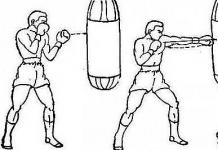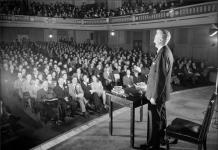fashion
Ulyana Sergeenko
Designer Ulyana Sergeenko showed two couture collections - at the June and January Haute Couture Fashion Week in Paris, completing her triumphant conquest of the world's catwalks. Ulyana Sergeenko Haute Couture dresses were purchased by all imaginable celebrities, led by Lady Gaga, and The New York Times launched the concept of the Russian pack solely because of Ulyana. Considerable credit for the success of the fashion house belongs to the brand manager of the Ulyana Sergeenko brand, Frol Burimsky.

How do you remember St. Petersburg from your youth?
My childhood was spent in Kazakhstan, where I grew up in a typical Soviet family, and, probably, the most joyful and bright memories remained there, in distant Ust-Kamenogorsk. When we moved to St. Petersburg, I was sixteen and I entered the university. The first years of life here are associated with the chilly classrooms of the St. Petersburg State University buildings on Vasilyevsky Island and constant rain. My mother, grandmother and brothers still live in St. Petersburg; I gave birth to my son here. There are many personal memories associated with the city, and I love it very much. And of course, its unique appearance remains in my memory - sometimes I notice how familiar motifs partly appear in the collection, in its palette, in individual elements, in the mood of certain things. This probably happens on a subconscious level.
What do you associate the city with - what people, places?
With Tsarskoe Selo, one of my favorite places on Earth. With the Yusupov family - they were amazing people with amazing taste. With a wonderful time - the beginning of the 20th century, when art, literature and fashion flourished. I would like to be in St. Petersburg at that time.

What cityscapes or interiors would be ideal for a photo shoot of your collections?
Last fall we already shot our first haute couture collection in the interiors of the Brusnitsyn mansion and in the Peter and Paul Fortress. St. Petersburg, full of amazing beauty of palaces, mansions and parks, perfectly suits the fairy-tale and magical mood that I want to convey in my collections.
What items from your collection of clothing and accessories were found in antique shops in the city, or found at the market on Udelnaya?
Recently, in an antique store, I found two volumes of a rare edition by Belinsky and a beautifully illustrated “Bakhchisarai Fountain” by Pushkin. Whenever I come to St. Petersburg, I always visit Udelnaya. It was funny when, after the first Paris show, Frol and I found a flask painted with flowers. A similar accessory, decorated with embroidery, was in our autumn-winter haute couture collection.
Do you think that the residents of St. Petersburg have their own style?
Of course there is, and very recognizable. He always seemed romantic and a little careless to me. I myself am a big fan of Tatyana Parfenova; it seems to me that her clothes are the quintessence of St. Petersburg style.

Lately, St. Petersburg has become quieter and quieter; the townspeople are inventing their own world in which to live. What do you find attractive here now?
The fact is that St. Petersburg lives by its own rules, it has its own rhythm, its own values, heroes and atmosphere.
You often have to be in the public eye. However, you give the impression of a person who prefers solitude and a chamber environment. What do you like to do when you're alone?
Yes, indeed, I really love solitude and never suffer from loneliness. I can always keep myself busy reading, watching movies, walking, and just daydreaming for hours.
When you have questions about yourself and about life, where do you look for the answer?
When you really ask questions, answers come from everywhere.
You have a special gift of not only seeing beauty, but also inventing it. By looking at many things through your eyes, people also begin to see beauty where they had not noticed it before. What do you find beautiful currently?
I try to spend more and more time in nature - it is perfect, harmonious, charges with positive energy and gives peace.
What thought recently made a serious impression on you and, perhaps, changed you?
The idea that there is only one recipe for happiness: love, loyalty, honesty, service and work.
Interview: Yana Miloradovskaya
Photo: Nick Sushkevich
Ulyana Sergeenko is one of the most recognizable women in the fashion world. Moreover, all we know about her are external attributes: delicate taste, aristocratic beauty, a rich husband. Ulyana practically doesn’t give interviews, and behind her stern appearance, many guess a cold and closed person. What is Ulyana Sergeenko really like? Thanks to what qualities (not attributes) was she able to become so famous and popular in such a short time?

A good education.
In principle, education is the foundation of any success. In the case of Ulyana, it probably also played a formative role for her aesthetics. The personal style and collections that she creates as a designer are imbued with intellectual elegance, so to speak. After school, Ulyana had the opportunity to become a model, but at the insistence of her parents, she did not fly to Paris to pursue a career, but remained in Russia and graduated from the Leningrad Humanitarian University. Without a classical education, it is unlikely that there would be the depth of penetration into culture that is in her collections, and which distinguishes Ulyana from other designers.

Know what you want.
Again the truism. But while the majority likes and shares motivational pictures, only a few know how to follow their dreams. Ulyana knew what she wanted from life even at school - at least that’s what her former classmates say about her. In a rare interview that the designer gave to her friend and part-time editor of SCN magazine Ksenia Sobchak, Ulyana shares: “I dreamed of becoming a heroine - a brave and determined woman who can do anything.” Moreover, the designer often draws visualization sheets - always new ones, as the previous ones come true!
“I have been interested in fashion for a long time, I always dreamed, even as a child, that I would wear couture... I didn’t even think that everything would turn out like this, that couture would be somehow connected with my name, that those desires of mine would come true through completely unexpected maneuvers. It's so amazing…"

Passion for work.
The press and bloggers created a certain image of Ulyana Sergeenko - a rich and beautiful girl who constantly travels to fashion shows. We hardly see her in a work environment, and it may seem as if fame and success are given to her just like that, solely thanks to publicity. In fact, the craft of a designer is a job that requires mental and physical effort. Ulyana knows the secret of success in the field she has chosen: in order to conquer the world of fashion, “first of all, you need to have sincerity, love, and even, rather, passion for your business. And of course, great efficiency.” And judging by the fact that her haute couture collections are shown on the same catwalk as Chanel, she successfully uses this secret.

Innate sense of style.
They say you can take a girl out of the village, but you can’t take the village out of the girl. This principle works the other way around - if a person has a sense of style, it only crystallizes over time. There is information that in Ust-Kamenogorsk, where Ulyana Sergeenko grew up, she differed from her peers in her appearance and desire to stand out. While studying at the gymnasium, she rejected the school uniform and sometimes argued about this topic with the school authorities. It is quite natural that under conditions O More than ever, Ulyana's sense of style became a subject of imitation and admiration.

Unique image.
Ulyana plays with eras like dolls - either she is a peasant young lady in a scarf and a polka dot dress, or a girl from the 50s in a fluffy skirt in the new look style, or a lady of the Victorian era. At the same time, her image is absolutely holistic. Obviously, there is an internal core on which the girl strings her images, creating a picture called “Ulyana Sergeenko’s style.” We would define it this way: a mixture of femininity, elegance and intelligence, thanks to which each look, regardless of the historical message, turns out to be beautiful, romantic and deep.

A successful marriage.
Unfortunately, or fortunately, the fact remains: a husband can play a significant role in a woman’s success if he is chosen correctly. We, who not only supports his wife in her work, but also manages all Prada affairs. In the case of Ulyana, she came into the light, where she began to be noticed, thanks to the status of her husband - Daniil Khachaturov is the head of Rosgosstrakh. And then her extraordinary sense of style played a role. But would it help if she were a teacher in Ust-Kamenogorsk?
“I admit it. But it is also quite obvious that this is not the only rich husband, and I am not the only rich wife... A person sees only what he wants” - Ulyana Sergeenko about her husband’s patronage.

Style à la Russe.
It is no secret that Russian culture has been exciting Western aesthetic receptors for many centuries. Polka dots, flowers, scarves - several years ago it was the image of a Russian young lady that brought recognition to Ulyana, and then popularity. She began appearing on fashion blogs and released several collections in this vein. Thanks to Ulyana, as well as her friends and colleagues (for example, Vika Gazinskaya, with whom she designed the first collection), Russian girls became not just an object of the press, but a whole phenomenon in fashion called “the Russian fashion pack.”
Breakups of the rich and famous are always fertile ground for numerous rumors and speculation. Therefore, the divorce of the 34-year-old “queen of Russian couture” Ulyana Sergeenko and 43-year-old billionaire Daniil Khachaturov quickly became one of the most discussed topics not only in the capital’s circle, but also in all Russian media. While the public is wondering what (or who) became the fatal “last straw” in the couple’s relationship, Woman.ru decided to remember what the marriage of a billionaire and a designer was like.
How Ulyana Sergeenko and Daniil Khachaturov met is a mystery shrouded in darkness (like the first three years of their relationship). Before becoming the lover of the owner of the Rosgosstrakh company, the ambitious beauty, who moved from her native Ust-Kamenogorsk to St. Petersburg, raised her son from a civil marriage alone. But this fact did not bother the billionaire at all. 
“He didn’t know that I already had a child. One day Danil invited me to a restaurant, and I came with a little boy by the hand, he was three and a half years old. And I was very glad that my future husband immediately accepted my son,” Sergeenko recalled in an interview with OK magazine. Khachaturov, by the way, was officially married then, but did not hide his new love from his first wife for long and in 2007 filed for divorce. 
2In conversations with journalists, Sergeenko honestly called the meeting with her husband “a gift of fate,” and Khachaturov himself, “a handsome prince.”
3Daniil Khachaturov and Ulyana Sergeenko officially registered their relationship in 2008. 
By this time, in addition to the beauty’s son, the couple was already raising their common daughter Vasilisa, who at that time was 2 years old. 
4The first appearance of Ulyana Sergeenko as the wife of Daniil Khachaturov took place at the celebration of his 35th birthday. The beauty even came up with a small creative number for her beloved man - wearing a white wig in the style of Marilyn Monroe and a translucent dress, she went up on stage and in a languid voice performed the signature number of the main blonde of the 20th century, Happy Birthday, Mr. President. “Mr. President,” of course, could not help but appreciate this gift.
5Classic films, many of which inspired Sergeenko to create collections, she first watched with her husband - neither in childhood nor in youth, oddly enough, Ulyana did not have such an opportunity. 
But for Daniil Khachaturov, watching a good movie every night is a long-standing tradition.
6Ulyana Sergeenko still owes the successful start of her career in the fashion industry to her billionaire husband: renting the Parisian Marigny Theater, inviting the legendary fashion figure Alexandre de Betak as a show director, not to mention other expenses - all this costs serious money. However, the “queen of Russian couture” is not like those “Rublev’s wives” who are accustomed to spending their spouses’ money on an industrial scale without regard and only for themselves. 
“I always internally cringe when I have to voice expenses to him (Daniil Khachaturov - Woman.ru),” Ulyana admitted in an interview with Tatler magazine in 2012, when everything was just beginning. But the designer, despite the gossip of envious people, paid for the PR services of the almighty Carla Otto out of her own pocket - the Ulyana Sergeenko brand quickly began to bring profit to the founder - and quite a good one. 
7On the eve of the first Ulyana Sergeenko couture show in Paris, Daniil Khachaturov was so worried about his wife’s psychological state that he took a 10-day vacation to help her manage the team and “reconcile debits with credits.”
Until a certain point, the billionaire sincerely considered his wife’s brand a “whim and a toy,” but imagine his surprise when, in the first year of work, Sergeenko and the brand’s managing partner Frol Burimsky managed to “break even,” that is, actually recoup all the money invested in PR , organizing shows in Paris and producing collections.
8Daniil Khachaturov did not miss a single Ulyana Sergeenko show, but always preferred to remain in the shadow of his chosen one. Usually, the couple’s daughter, Vasilisa, sat on the businessman’s lap during the show. 
Once, by the way, Khachaturova Jr. even appeared on the catwalk in her mother’s show as a model demonstrating an outfit from the brand’s children’s line. 
9Over the 7 years of marriage, the billionaire and the designer were loudly “divorced” twice, in 2013 and 2014 - Tatler and Forbes magazines rushed to list the billionaire as an “eligible bachelor”, and the SNC publication, which at that time was headed by Ksenia Sobchak, even named the girl’s name, from -for which the boat of love “worth billions” almost crashed. Both times, Khachaturov and Sergeenko had the wisdom to maintain their relationship and refute all rumors. But 2015 was fatal for the businessman’s family - they really decided to separate, and on the initiative of the businessman. 
10It is noteworthy that in the column “Reason for divorce,” Daniil Khachaturov indicated: “The impossibility of further preserving the marriage.” The court will decide on September 30 which of the spouses 9-year-old daughter Vasilisa will stay with after the divorce. Her mother helps Sergeenko in raising children: the designer does not trust nannies and tries to keep her son and daughter strict: for example, she does not allow them to drink Coca-Cola or use certain gadgets, including the iPad. 

The main popularizer of Russian style in the West, Sergeenko met with L’Officiel - and honestly spoke about the difficulties of lace making, working with Edward Enninful and organizing couture shows in two months.
17.11.2017
Irina Shcherbakova
Reading time 2 minutes
Ulyana Sergeenko, the person who introduced the fashion industry to modern Russian couture, comes to an interview not in an embroidered coat or a floor-length velvet cape, but in a comfortable dark green parka. And not in stiletto heels, but in pumps with practical small heels - the kind that the American fashion press affectionately calls sensible shoes. This is, let's say, quite unexpected.
However, even something as basic as a parka, Ulyana has her own brand. That is, it is also far from pret-a-porter; Neither Sergeenko nor her team use the word itself in their work. The more “wearable”, casual line items are treated like demi-couture: they are all made by hand, each using a clever closed seam - so that the inside of any dress or jacket looks exactly the same as the outside. “The simplest trousers at first glance,” says Sergeenko, “we can take a very long time to adjust. Endlessly lead to this simplicity. It even happens that after all these adjustments, the thing doesn’t go anywhere: you just get tired of fighting with it.”
If Ulyana Sergeenko takes sewing black dress pants so seriously, it’s not hard to imagine how things are going with her evening dresses - the same ones that Dita Von Teese, Natalia Vodianova or, for example, Game of Thrones star Emilia Clarke willingly walk on the red carpet. “Can you imagine what it’s like to make Vologda lace on a large scale? - Sergeenko argues. “Everything is woven by hand, tiny fragments into a large whole. And the word “big” here is not an exaggeration - the first wedding dress we worked on, for example, was really huge. The full production cycle is longer than six months. When we handed in the work, we were terribly afraid and kept our fingers crossed. Final assembly, the bride is waiting. Brides, you know, usually lose weight due to stress before the wedding. Perhaps there are more complicated things than this dress, I don’t remember.”
“I have to say this, but often things no longer have any value. But many people, on the contrary, want them to have something real. Something well made, timeless, into which they put a lot of soul and work. I see that non-couture clients, people who do not buy couture constantly and in huge quantities, come for a coat that they can always wear.”
Sergeenko works and receives guests in Granatny Lane; here there is a demi-couture store, a showroom and an atelier where client orders are sewn. The couture itself, which will then go to Paris Fashion Week, the “circulation” and items from the capsule collections are sewn at Krasnoselskaya: “All production is there.” Inside the relatively new building in Granatny, everything is antique: high ceilings, white walls with barely noticeable stucco, like in a proper St. Petersburg front door. It seems quiet here, but not deserted - one employee Ulyana Sergeenko comes down the stairs with several sealed boxes, another, in a long fitted dress with a flower and Vetements ankle boots with “lighter” heels, politely says hello as she runs past.
The brand’s symbol, the red rocking horse, flashes everywhere: its silhouette adorns the lock of classic leather Ulya bags, it is engraved on gilded signs near individual rooms, and its image is hung on the door of the room where the client is located, instead of the usual “Do not disturb” sign. . In one room of the showroom it is easy to count seven horses at once: a meter-long one on the window, two smaller ones on the cabinets, very small ones placed between hats, headdresses encrusted with stones from past collections and clutches from different times.
The showroom itself is somewhat different from the austere interiors of the offices in Granatny. From the front door you find yourself in a quaint museum-apartment, also St. Petersburg in spirit - wallpaper with roses, portraits of Turgenev, Mayakovsky and Akhmatova on the walls, flowers in tubs. From the speakers comes the art-pop group Anthony and the Johnsons, who at different times recorded songs, either as a duet with Björk, or with vocals by David Lynch, or with poems by Poe. The entire team came up with the design for the showroom. Someone brought and placed on the cabinet a Dulevo porcelain figurine, someone a porcelain girl trying on a dress - produced by LFZ. The antique floor lamps were accidentally found by Ulyana’s partner Frol Burimsky. The book “Russian lace and Russian lacemakers” from 1892 was donated by one of the clients. Lace is one of the topics that especially interests Ulyana. This year she held an exhibition at the Vologda Lace Museum, which she later brought to London, and even, with the help of one of the lacemakers, gave the British a weaving master class.
When asked about Western interest in everything Russian, Ulyana Sergeenko shrugs: “Everyone, for example, knows about Diaghilev, Nijinsky, “Russian Seasons” - people read about them, look at costume sketches with pleasure, there was an exhibition not so long ago. But the point is not that Diaghilev and Nijinsky were Russians, but that they were truly brilliant people. I wouldn’t focus on “Russianness” at all—I get a little tired of it. Yes, I am proud that I am Russian, but the word “Russian” is closer to me. I think there is interest in everything Soviet in general. Kazakh, Uzbek, Caucasian."
The fashion press has been arguing for several seasons about what fate awaits couture in the next few years. Ulyana has her own opinion on this matter. “Couture has been buried for a long time,” she notes. “These conversations have been, are, and will probably continue to be had.” But what I personally noticed, as a person who works with a client... it seems to me that now the need for couture, on the contrary, has increased. Or not even specifically in couture - people just get tired of the constant change of trends. They get tired of the endless race for all these must-haves. You know, things go out of fashion instantly, and I have no idea what to do with them after that. You can't even sell them. I have to say this, but often things no longer have any value. But many people, on the contrary, want them to have something real. Something well made, timeless, into which they put a lot of soul and work. I see that non-couture clients, people who do not buy couture constantly and in huge quantities, come for a coat that they can always wear.”
Then Sergeenko adds: “I stopped buying clothes altogether. I come to the store and don’t know what to buy, why do I need something that will become irrelevant tomorrow? I miss simple, orphan dresses.”
In the photo: Ulyana Sergeenko spring-summer 2013
Ulyana can understand: the main boots, bags and hoodies of the season become outdated before they even appear on the shelves. During the six months that in most cases pass between the show and the start of sales, they manage to be filmed dozens of times for gloss, reposted hundreds of times on Instagram, and a significant number of analytical articles are devoted to them in the spirit of “why Crocs with rhinestones are the new sleepers with fur” and safely forget.
One of the ways to live in the new fashion world is deliberate asceticism, refusal of fashion in principle, uniform clothing: simple blue jeans, simple white sneakers, several identical men's shirts. Another way is also a rejection of must-haves, but not asceticism, but couture and demi-couture in favor of custom-made items that can last for years.
According to Ulyana, white sneakers and hand-painted buttons from Rostov have equal rights to existence. “For me,” says Sergeenko, “it’s a matter of personal choice. Some are now playing with the new fashion, more democratic, while others remain adherents of old values. For me, the main thing is quality, cut and couture approach. You and I may not have the same points of view, but it’s good that we have the opportunity to choose.”
Ulyana recalls her first years in the industry in detail and clearly with pleasure. “We ourselves did not expect that everything would turn out so well. We didn’t think that we would be so in demand, that something more would grow out of a chamber story. We had absolutely no plan. Yes, we made mistakes many times, but we did some things right purely intuitively. And it couldn't have been better. We didn’t know how to do it, but for some reason we did it that way. If I went back to that time, I wouldn't change a thing. I love these mistakes, and I’m proud of the intuitively made right decisions.”
Were there decisions that she did not expect from herself? “I’ll tell you more,” Ulyana answers, “if now someone came to me with most of the ideas that we implemented at the very beginning, I would simply never take it up. I would say: this is impossible. It’s simply impossible, that’s all. As for decisions, the bravest thing was probably to start everything. No, it’s not that I somehow idealize fashion. I understood what was behind any pretty facade, I understood that fashion is, first of all, work, the work of people. But I didn’t realize how much work I needed to do. And by the way, how many things had to change in myself.”
Sergeenko pauses. “Our first couture show,” she says, “was reckless. Now, in two months, I definitely wouldn’t dare to do something like that so easily. But then, I remember, at the end of April, Natasha (Vodianova. - Note ed.) were sitting in a cafe, and she suggested an idea: “Ulyana, this is couture, do couture things!” And I didn’t even know who a casting director was! I sincerely didn't know. And Natasha explained all this to me along the way.”
First couture show of Ulyana Sergeenko, fall-winter season 2012/2013The debut couture show, like the subsequent ones, was styled by Sergeenko herself, which is, in principle, rare. Ulyana made an exception only in order to attract Edward Enninful. The first show he worked on took place at the oldest existing circus in Paris last winter, shortly before Enninful was appointed editor-in-chief of British Vogue magazine.
“It was difficult to decide,” says Ulyana. “I have always styled shows myself, and for me letting someone close to such a personal story was unimaginable. But we have a team of young guys, all with ambitions, everyone is interested. They persuaded: “Ulyana, why are you always on your own, well, you need to be more fashionable.” I followed the guys' lead. I can’t say that I was eager to do this myself, but I wanted to show the team something new and learn myself. Oh, that was very traumatic. We all had a hard time surviving the first show. Even then the team howled: “Why did we even ask for this?” Edward forced everything to be redone, and in almost two days. I myself, of course, would not stylize this way in life; initially things looked completely different. Stephen Jones worked on the caps for the collection, beautiful beaded caps - a most challenging job! But not a single hat came out; Edward rejected everything. I went around crying, Stephen Jones was also upset, but I couldn’t say anything to Edward personally, I didn’t want to offend him. Natasha Vodianova stood between us, and I complained to her in a whisper in Russian. And only after going through all this, we realized how we should continue to work with Edward.”
“Stephen Jones worked on the hats for the collection, beautiful beaded hats - a most difficult job! But not a single cap came out, Edward (Enninful . — Approx. ed.) rejected everything. I went around crying, Stephen Jones was also upset, but I couldn’t say anything to Edward personally, I didn’t want to offend him. Natasha Vodianova stood between us, and I complained to her in a whisper in Russian. And only after going through all this, we realized how we should continue to work with Edward.”
Does Sergeenko often indulge the team - and what kind of boss is she anyway? “They say I’m a tyrant,” Ulyana laughs. “But maybe it’s because I didn’t plan to be a boss.” It is very difficult for me to manage so many people. I think that I can’t be a manager, I’m still too emotional. How do I deal with all this? I won't lie - I can't cope. But I’m glad that there are people I can rely on.”
Photos of Ulyana: Danil Golovkin
Nevertheless, Miroslav Duma almost immediately left the board of directors of the children's online store The Tot, which she founded. How commented co-founder of the project Nasiba Adilova, “racism is unacceptable in any form, even if it is accidental and unconscious.”
On the night of January 23, the Duma was reminded of other statements. For example, in 2012, during her lecture on “fashion on the Internet,” she said that Buro 24/7, which she runs, would never feature transgender models a la Andrea Pejic or men who wear women’s clothing. “I don’t feel good about this. Somewhere in a magazine or on TV, a little boy might see [this] and understand it incorrectly, react to it incorrectly. I believe that some kind of censorship or culture should be present in this sense,” the Duma said. In the same lecture, she said that she was too worried about the beauty of the pictures on her website, so there would be no articles about socialite Kim Kardashian either.
Video excerpts from the lecture were provided with English subtitles. After this, the Duma was accused of transphobia and hypocrisy. It is worth noting that Miroslava kept this word only partially: today on the Buro 24/7 website

























